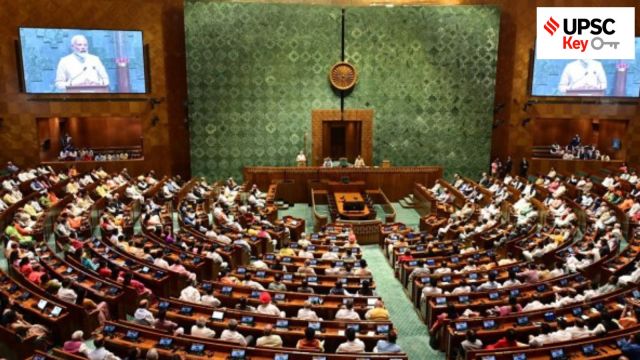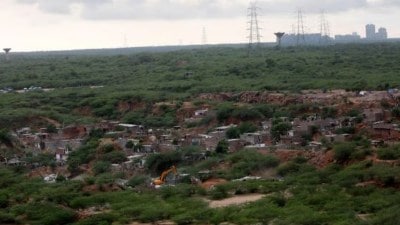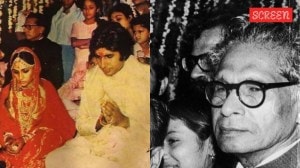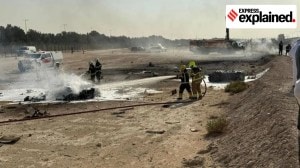🚨 The Indian Express UPSC Essentials brings to you the May edition of its monthly magazine. Click Here to read. Share your views and suggestions in the comment box or at manas.srivastava@indianexpress.com🚨
Explained
UPSC Syllabus:
Preliminary Examination: Indian Polity
Mains Examination: GS-II: Governance, Constitution, Polity.
What’s the ongoing story- As the 18th Lok Sabha prepares to meet, the TDP and JD(U), key allies of the BJP in the National Democratic Alliance (NDA), are said to be jockeying for the post of Speaker. After a pro tem or temporary Speaker administers the oath to new members, the Speaker is chosen to be the Presiding Officer of the House.
Prerequisites:
— Who appoints the pro-tem Speaker?
— What are the duties of the pro-tem Speaker?
— What are the constitutional provisions related to the Speaker?
Key takeaways:
— The Speaker has a key role in parliamentary democracy. The Constitution of India provides for the offices of the Speaker and Deputy Speaker who, according to Article 93, are to be elected “as soon as may be” after the commencement of the House.
— The Speaker is elected by a simple majority in the House. The term ends with the dissolution of the House, unless the Speaker resigns or is removed from office before that.
— A motion of no-confidence can be moved against the Speaker with notice of 14 days as per Article 94 of the Constitution. Separately, the Speaker, like any other member of the House, can face disqualification.
Story continues below this ad
— There are no specific qualifications for becoming Speaker, which means any member is entitled to be considered. However, the post of Speaker is distinct from other members in the House.
— The salary of the Speaker is drawn from the Consolidated Fund of India unlike for other MPs, which flow from a statute voted on by the House itself.
— Powers of the Speaker
1. Conducting house: The conduct of government business is decided by the Speaker in consultation with the Leader of the House. Prior permission of the Speaker is required for members to ask a question, or to discuss any matter.
2. Question and Records: The Speaker decides the admissibility of a question raised by a member, as well as how the proceedings of the House are published. The Speaker has the power to expunge, in full or in part, remarks that she may consider to be unparliamentary. Critical remarks against the ruling party may not be published if the Speaker decides to expunge them.
Story continues below this ad
3. Casting Vote: According to Article 100 of the Constitution, which talks about voting in the Houses, the Chairman of Rajya Sabha or Speaker of Lok Sabha, or any person acting as such, “shall not vote in the first instance, but shall have an exercise a casting vote in the case of any equality of votes”.
4. No-confidence Motion: One of the most important times when a Speaker’s impartiality impacts the Opposition is when a motion of no-confidence is moved against the government.
5. Disqualification of members: The Tenth Schedule or the anti-defection law, introduced to the Constitution through the Fifty-Second (Amendment) Act, 1985, gives the Speaker of the House the power to disqualify legislators who ‘defect’ from a party. In the landmark case Kihoto Hollohan versus Zachillhu in 1992, the Supreme Court upheld the power vested in the Speaker and said that only the final order of the Speaker will be subject to judicial review.
— In 2020, the Supreme Court had ruled that Speakers of Assemblies and Lok Sabha must decide disqualification pleas within three months except in extraordinary circumstances.
Points to Ponder:
— What are the roles and responsibilities of the Speaker?
Story continues below this ad
— What is the process for the removal of the Speaker?
— What are the issues associated with the office of the Speaker and its functioning?
— What are the grounds for disqualification under the anti-defection law?
Post Read Question:
Consider the following statements: (UPSC CSE 2017)
1. In the election for Lok Sabha or State Assembly, the winning candidate must get at least 50 percent of the votes polled, to be declared elected.
Story continues below this ad
2. According to the provisions laid down in the Constitution of India, in Lok Sabha, the Speaker’s post goes to the majority party and the Deputy Speaker’s to the Opposition.
Which of the statements given above is/are correct?
(a) 1 only
(b) 2 only
(c) Both 1 and 2
(d) Neither 1 nor 2
Other Important Articles Covering the same topic:
Explained: How are a Speaker and Deputy Speaker elected?
UPSC Syllabus:
Preliminary Examination: Current events of national and international importance
Mains Examination: GS-II: India and its neighbourhood- relations, bilateral, regional and global groupings and agreements involving India and/or affecting India’s interests.
What’s the ongoing story- The President of Maldives, Mohamed Muizzu, was one of seven leaders from India’s neighbourhood who attended Prime Minister Narendra Modi’s swearing-in at Rashtrapati Bhavan on Sunday evening (June 9). Muizzu’s presence was significant, given the way he has positioned himself politically vis à vis India, and the crucial strategic aspect to the India-Maldives relationship.
Prerequisites:
Story continues below this ad
— What is the “India Out” poll plank of President Muizzu?
— What are the Neighbourhood First policy and SAGAR vision of India?
— What is the history of India-Maldives bilateral relations?
(Thought Process: Historical Evolution of the Relationship, Trade and Economic Ties, Defence, Recent MoUs, and Hydrographic Surveys)
— Map work: Location of the Maldives, Lakshadweep’s Minicoy Island.
Key takeaways:
Story continues below this ad
— Muizzu came to power on November 17 last year on an ‘India Out’ plank. The India Out campaign had begun in 2020 as the Maldives opposition’s protest against then President Ibrahim Solih’s policies that were perceived to be friendly towards New Delhi, but had soon turned into a movement against India’s alleged military presence in the archipelago, which both the Solih government and India denied.
— Muizzu demanded the withdrawal of all Indian military personnel from Maldives. Consequently, the final batch of Indian soldiers — who were stationed in the Maldives to operate and maintain two helicopters and three Dornier aircraft India had previously gifted to the country were replaced by civilians in May.
— Like his mentor, former President Abdulla Yameen Abdul Gayoom, under whose rule (2013-18) the India-Maldives relationship deteriorated severely, Muizzu has openly aligned his country with China, India’s geopolitical rival in the Indian Ocean.
— The Chinese influence in the Maldives has increased steadily over the past couple of decades. The island nation is part of China’s Belt and Road Initiative, which has led to an influx of Chinese money and a strengthening of the relationship between the two countries — at the expense of India.
Story continues below this ad
— For India, the Maldives is a crucial ally, important to secure its maritime periphery and to keep an eye on the larger Indian Ocean region where China is making aggressive moves.
— Regardless of Muizzu’s pro-China, anti-India posturing, the Maldives cannot simply “let go” of India. It is heavily dependent on Indian imports in almost all important sectors, from food to life-saving medicines, and aircraft used in search and rescue missions.
— At a time when relations between India and the Maldives are at a low, Muizzu’s visit sends an encouraging signal. Some groundwork for a reset in the relationship has been done over the past couple of months.
— In April, India approved the highest-ever export quotas for essential commodities — eggs, potatoes, onions, sugar, rice, wheat flour and pulses, river sand and stone aggregates — to Maldives for 2024-25 under a unique bilateral mechanism that has been in effect since 1981.
For Your Information:
— Significance of Maldives for India: Maldives’ proximity to the west coast of India, and its location at the hub of commercial sea lanes running through the Indian Ocean imbues it with significant strategic importance to India. The security scenario in India’s periphery in the Indian Ocean is very much linked to the maritime strength of Maldives.
Points to Ponder:
— What are the points of cooperation between India and the Maldives?
— What are the major challenges to India-Maldives relations?
— What steps can be taken by India to strengthen bilateral relations with the Maldives?
— What is the significance of India for the Maldives?
(Thought Process: Mention the essentials that India supplies to the Maldives, India’s support in the Maldives’ education system, the economic dependence of the Maldives on India—tourism—and India’s significant role during disasters.)
Post Read Question:
Prelims
India and Maldives are separated by which of the following channels?
(a) Seven Degree Channel
(b) Eight Degree Channel
(c) Nine Degree Channel
(d) Ten Degree Channel
Mains
Discuss the political developments in the Maldives in the last two years. Should they be of any cause for concern to India? (UPSC CSE 2013)
Other Important Articles Covering the same topic:
India-Maldives ties: Amid row, why the two countries need each other and what is at stake
Govt & Politics
UPSC Syllabus:
Preliminary Examination: Economic and Social Development
Mains Examination: GS-II: Government policies and interventions for development in various sectors.
What’s the ongoing story- Chairing the maiden Cabinet meeting of his third term on Monday, Prime Minister Narendra Modi approved government assistance for the construction of three crore rural and urban houses under Pradhan Mantri Awas Yojana (PMAY).
Prerequisites:
— What is the Pradhan Mantri Awas Yojana (PMAY)?
— What is the PM Kisan Samman Nidhi (PM-Kisan) Yojana?
Key takeaways:
— Of the three crore houses, two crore will be constructed under PMAY-Gramin, while 1 crore under PMAY-Urban. After the Cabinet meeting an official source said, “It has been decided in the Cabinet meeting today to provide assistance to three crore additional rural and urban households for the construction of houses, to meet the housing requirements arising out of the increase in the number of eligible families.”
— Under the PMAY-G, each beneficiary gets funds up to Rs 1.2 lakh in the plains and Rs 1.3 lakh in hilly states, difficult areas, and tribal and backward districts under the Integrated Action Plan (IAP). It is also learnt that the Centre has decided to increase the assistance provided to the beneficiaries under the PMAY-G by about 50 per cent. The sources said the Centre has decided to increase the cost of construction of the PMAY-G house from existing Rs 1.2 lakh to Rs 1.8 lakh in the plains and Rs 1.3 lakh to Rs 2 lakh in the hilly areas.
— These additional 2 crore PMAY-G houses will be over and above the 2.95 crore houses sanctioned under the rural scheme since its inception in 2016. Of these 2.95 crore, 2.61 crore have been built under the PMAY-G till date.
— The Centre and states share expenses in 60:40 ratio in case of plain areas, and in 90:10 ratio for northeastern states, two Himalayan states and the UT of Jammu and Kashmir. The Centre bears 100 per cent cost in case of other Union Territories, including the UT of Ladakh.
— The PMO said after being sworn in as the Prime Minister for the 3rd time, Modi signed his first file authorising the release of 17th instalment of PM Kisan Nidhi.
For Your Information:
— The government had launched the Pradhan Mantri Awas Yojana (Urban) on June 25, 2015, to provide pucca houses to all eligible beneficiaries by 2022. The scheme has four verticals: “In-situ” Slum Redevelopment (ISSR); Credit Linked Subsidy Scheme (CLSS); Affordable Housing in Partnership (AHP) and Beneficiary-led individual house construction/enhancements (BLC),
Points to Ponder:
— What is the difference between PMAY (rural or Gramin) and PMAY (urban)?
— What are the criteria for the selection of beneficiaries for PMAY-G and PMAY-U?
(Thought Process: Know about the Socio-Economic Caste Census)
— What are the limitations of PMAY?
— What are the other infrastructure and rural development-related schemes?
Post Read Question:
Consider the following Statements regarding Pradhan Mantri Awaas Yojana-Urban:
1. The government had launched the PMAY-Urban in 2016.
2. Under the scheme guidelines, an adult earning member (irrespective of marital status) can be treated as a separate household.
3. It is mandatory for the state government to ensure that all houses built under the scheme are geotagged to the Bhuvan HFA (housing for all) application.
How many of the statements given above are true?
(a) One only
(b) Two only
(c) All three
(d) None
Other Important Articles Covering the same topic:
Explained: What is PMAY-U? Who can avail it?
The Editorial Page
UPSC Syllabus:
Preliminary Examination: Indian Polity
Mains Examination: GS-II: Functions and responsibilities of the Union and the States, issues and challenges pertaining to the federal structure, devolution of powers and finances up to local levels and challenges therein.
What’s the ongoing story- Louise Tillin writes- “The return to coalition government, including regional parties as key power-brokers, as well as the BJP’s greater electoral stake in south India (and the Opposition’s in the north), is an inflection point at which trust and balance could be restored in matters of federalism.”
Prerequisites:
— What is a coalition government?
— What is federalism?
— What are the constitutional provisions concerning the Centre-State relations?
Key takeaways:
— “The return of coalition politics in India will bring questions of federalism and Centre-state relations back to the fore.The BJP’s greater reliance on its regional allies, and its expanded stake in southern India, offers the potential for a federal reset. But whether this will happen is unclear.”
— “Since 2014, the BJP has introduced a number of changes in the domain of Centre-state relations. In Modi 1.0, the government began by abolishing the Planning Commission and establishing in its place Niti Aayog with a mandate for strengthening cooperative federalism. It went on to establish the Goods and Services Tax, arguably the most significant reform to fiscal federalism since the promulgation of the Constitution.”
— “In Modi 2.0, the government began its term in office with the abrogation of Article 370, a move that underlined a turn towards a deeper degree of centralisation and the use of a secure parliamentary majority to pursue one-nation policy ideas that often rode roughshod over the interests of states. The poll-eve pledge to proceed with “One nation, one election” was to be a continuation of this agenda.
— “Governing in coalition will introduce multiple centres of power, pushing against the centralisation of decision-making in the Prime Minister’s Office. But we shouldn’t assume that regional parties themselves are strong votaries for strengthening federalism.”
— ‘Special-interest regional politics — if it is the price for coalition in 2024 — may threaten a wider federal bargain if it bolsters the impression that partisanship rather than principles determine the distribution of resources across regions within India.”
— “On many occasions since 2014, Prime Minister Modi has appealed for more cooperative working between the Centre and the states in India’s national interest. Strengthening the institutional space for dialogue and decision-making between the Centre and all states, not just NDA-governed states, should be a priority.”
— “The simplest way to do this would be to empower the Inter-State Council, established following the Sarkaria Commission on Centre-state relations in the late 1980s….Giving it greater independence and statutory responsibilities would strengthen the space for both Centre-state, and inter-state, dialogue.”
For Your Information:
— A coalition government involves more than one political party or individuals working together, sometimes with differing viewpoints.
Points to Ponder:
— Does the coalition government strengthen federalism or present a challenge to it?
— What are the challenges to centre-state relations?
— What are the measures taken by the government to strengthen federalism in the country?
(Thought Process: Read about the NITI Aayog, Goods and Services Tax, and other initiatives.)
— What steps should be taken to strengthen centre-state relations?
Post Read Questions:
Prelims
Which one of the following is not a feature of Indian federalism? (UPSC CSE 2017)
(a) There is an independent judiciary in India.
(b) Powers have been clearly divided between the Centre and the States.
(c) The federating units have been given unequal representation in the Rajya Sabha.
(d) It is the result of an agreement among the federating units.
Mains
Though the federal principle is dominant in our constitution and that principle is one of its basic features, but it is equally true that federalism under the Indian Constitution leans in favour of a strong Center, a feature that militates against the concept of strong federalism. Discuss. ( UPSC CSE 2014)
Other Important Articles Covering the same topic:
Federalism in India: What you need to know
UPSC Syllabus:
Preliminary Examination: General issues on Environmental Ecology, Biodiversity and Climate Change- that do not require subject specialisation.
Mains Examination: GS-II, GS-III: Government policies and interventions, Conservation, environmental pollution and degradation, environmental impact assessment.
What’s the ongoing story- With the world warming up, the country needs a long-term policy to prevent water-related conflicts and ensure people do not suffer water shortages.
Prerequisites:
— What are the factors leading to the water shortages?
— What is Sahi Fasal Campaign?
— Read about the Pradhan Mantri Krishi Sinchayee Yojana and Atal Bhujal Yojana.
Key takeaways:
— The Narendra Modi government has accorded importance to providing tap water connections, but the health of aquifers continues to be neglected. The country has historically tried to address water deficits by focusing on supply-side parameters. In line with such an approach, the Centre has asked states to prepare inventories of water bodies as a first step towards preventing the encroachment of these aquifers. Much more needs to be done to tackle long-standing shortfalls.
— There is very little coordination between departments that deal with surface and groundwater, irrigation resources and drinking water. The few water-sharing arrangements between riverine states come apart during shortage seasons. And plans to harvest rainwater remain largely on paper, despite floods and dry spells alternating with worrying regularity in most parts of the country.
— In recent years, programmes such as the Sahi Fasal Campaign, Pradhan Mantri Krishi Sinchayee Yojana and Atal Bhujal Yojana have taken early steps to encourage efficient use of water in agriculture.
— Optimal use of irrigation resources is essential. However, demand-side management of water resources also requires analyses of practices at the household and industrial levels.
Points to Ponder:
— What are the impacts of the water crisis?
— What are the measures taken by the government to manage the water crisis?
— What steps should be taken to address the issue of the water crisis?
Post Read Question:
Suggest measures to improve water storage and irrigation system to make its judicious use under the depleting scenario. (UPSC CSE 2020)
Other Important Articles Covering the same topic:
India likely to be most severely affected as global urban population facing water scarcity projected to increase up to 2.4 bln in 2050: UN report

The World
13A debate kicks up in Lanka ahead of polls
UPSC Syllabus:
Preliminary Examination: Current events of national and international importance.
Mains Examination: GS-II: India and its Neighbourhood- Relations.
What’s the ongoing story- The India-mooted 13th Amendment to the Sri Lankan Constitution as a solution to address the minority Tamil community’s long-pending demand for political autonomy is set to figure high in the political debate in the impending presidential election.
Prerequisites:
— What is the history of India and Sri Lanka’s bilateral relations?
— Read about the ethnic conflict in Sri Lanka.
— Map work: Location of Sri Lanka, Katchatheevu Island, Palk Strait, Gulf of Mannar.
Key takeaways:
— Sri Lanka’s Elections Commission last month said the presidential election would be conducted between September 17 and October 16.
— A statement made by the main opposition leader Sajith Premadasa that a future government under his Samagi Jana Balawegaya (SJB) party would implement the 13A is being met with criticism.
— The 13A provides for the devolution of power to the Tamil community.
Points to Ponder:
— What is the Katchatheevu Island Dispute?
— What are the challenges in India-Sri Lanka relations?
— What are the areas of cooperation between India and Sri Lanka?
— What is the significance of Sri Lanka for India?
— What measures should be taken to strengthen India-Sri Lanka relations?
Post Read Question:
In respect of India-Sri Lanka relations, discuss how domestic factors influence foreign policy. (UPSC CSE 2013)
Other Important Articles Covering the same topic:
Sri Lanka approves bill to set up office for national unity as part of reconciliation efforts with Tamils
Far-right gains in EU election deal stunning defeats to France’s Macron, Germany’s Scholz
UPSC Syllabus:
Preliminary Examination: Current events of national and international importance.
Mains Examination: GS-II: Bilateral, regional and global groupings and agreements involving India and/or affecting India’s interests.
What’s the ongoing story– A four day election has shaken the foundation of the European Union, with the far right rocking ruling parties in France and Germany, the bloc’s traditional driving forces. For the next five years, it will be harder for the European Parliament to make decisions.
Prerequisites:
— What is the European Union (EU)?
— What are the member countries of the EU?
— Know about the history of the EU?
Key takeaways:
— French President Emmanuel Macron called snap national elections after Marine Le Pen’s National rally humbled his pro-European centrists in the polls. German Chancellor Olaf Scholz’s Social Democrats also suffered as the extreme-right Alternative for Germany shrugged off scandals to make massive gains.
— In Italy, the party of Prime Minister Giorgia Meloni won more than 28% of the national vote for the EU assembly, which would make it a key player in forming future alliances.
For Your Information:
— The European Parliament (EP) represents the citizens of its member states. Its primary functions include negotiating EU laws with the member state governments, which are represented by the European Council.
— The EP also approves the EU budget and votes on international agreements and enlargements of the bloc. It also has the power to approve or reject the appointment of the European Commission president — currently Germany’s Ursula von der Leyen — and the commissioners.
— Unlike national parliaments, the EP does not have the right to propose laws but can only negotiate those proposed by the executive European Commission.
— The EP comprises 720 Members (MEPs) elected every five years. The MEPs then elect their president for a term of two and a half years.
Points to Ponder:
— What is the significance of Europe for India?
— What are the areas of cooperation between India and EU?
Post Read Question:
Consider the following statements: (UPSC CSE 2023)
The ‘Stability and Growth Pact’ of the European Union is a treaty that-
1. limits the levels of the budgetary deficit of the countries of the European Union
2. makes the countries of the European Union to share their infrastructure facilities
3. enables the countries of the European Union to share their technologies
How many of the above statements are correct
(a) Only one
(b) Only two
(c) All three
(d) None
Other Important Articles Covering the same topic:
European Parliament elections this week: what happens & how?
UPSC Essay and Ethics Snippets
‘Wordly Wise’ from The Editorial Page
“What is above all needed is to let the meaning choose the word, and not the other way about.”
— George Orwell
(Thought Process: Is it the word or its meaning that defines the expression? Do you agree that sometimes words shape arguments but lose their essence because the shadow of words overcomes the meaning?)
Subscribe to our UPSC newsletter and stay updated with the news cues from the past week.
The UPSC articles of Indian Express is now on Telegram. Join our Telegram channel- Indian Express UPSC Hub and stay updated with the latest Updates.
https://www.youtube.com/watch?v=wsnxUastCeM?si=reb2W-O9oHY3dJN-



































